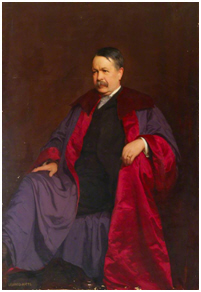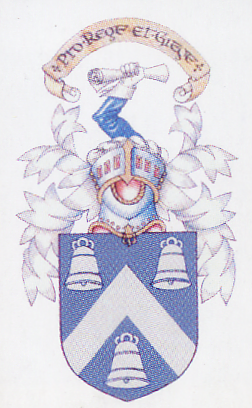|
Former Pupil Biographies
Professor
James Stuart (1843 - 1913)
| James Stuart of Balgonie came to St Andrews to stay
with his grandmother at 23 South Street and to attend Madras College.
He had led a very sheltered sort of existence and was perhaps just a
little bit snobbish because he says 'When I went to St Andrews and to
school, I found myself amongst a host of boys and girls, for both went
to the same school, who had been bred up in no such surroundings or,
at any rate, brought with them no aroma of them.' It is not quite
clear just what he means by aroma. Stuart encountered Dr. Adamson, the
pioneer of photography, and was delighted to be included in one of
his pictures, standing in front of the Castle. Stuart graduated from
St Andrews with a first in Classics and Mathematics went on to
Cambridge where he was again successful academically. |
 |
The first true professor of Engineering at Cambridge,
appointed in 1875 was a great reformer. James Stuart, a graduate in
mathematics at Trinity, played a leading role in establishing
inter-collegiate lectures at Cambridge and was also a great proponent of
higher education for women and for the working classes. To this end he
established a system of extra-mural lectures which led directly to the
establishment of the present, hugely popular, university extension
courses. The success of these two projects, as well as his reputation as a
scientist and engineer, made him an obvious candidate for a university
chair. The demand to teach engineering at Cambridge as a subject in its
own right had become pressing, especially as the result of the
recommendations of the Royal Commission of 1850 which had been asked to
review the teaching of the university. As a result, it was decided to set
up a new Professorship of Mechanism and Applied Mechanics (the word
'Engineering' had been rejected in the title).
One of the students who attended Stuart's early lectures was Sir Charles
Parsons, who invented the steam turbine. Later he designed the turbines
that powered the s.s. Turbinia, a naval sensation in its day, and the
forerunner of modern motive power for ships.
When James Stuart was appointed to the Chair of Mechanism and Applied
Mechanics, he was allocated a half share in a lecture room with two small
rooms behind, in the New Museums building on Free School Lane. Recognising
the importance of a practical training for engineers, he then persuaded
the University to give him a wooden hut to serve as a workshop for his
twenty-five students. This was done on the condition that he furnish and
equip it at his own expense. Charles Darwin and Gladstone were among the
early visitors to admire the new facility in 1878. After running the
workshop single-handedly for two years, the University eventually agreed
to provide him with assistance. As the student numbers rose, Stuart begged
for more space, and in 1882 the University allotted him two cottages in
Free School Lane, with a foundry in the garden of one of them. This was a
cause of great concern to the Professor of Botany over whose plants the
foundry tended to smoke!
In the summer of 1884, approval was given to add a third storey to the
building of what was then the Department of Mineralogy, to provide more
space for the engineers. Stuart and his Demonstrator, Lyon, evolved a
scheme for jacking up the existing roof (110ft long, weighing 50 tons) and
inserting new walls beneath it. With the help of the students, the whole
thing was accomplished in seventeen days during the Long Vacation, and
such was the accuracy of the calculations that 'not a single slate or nail
in the roof was broken or strained'. Not only did Professor Stuart have to
fight for new buildings and facilities; he had also to establish
Engineering as a Tripos exam. This he failed to do, having become rather
unpopular through his involvement with politics (he was elected Member of
Parliament for Hackney in 1884). General disagreements with the
University, particularly with regard to the value of the Workshop in the
teaching of engineering eventually led to Stuart's resignation in 1890. He
went on to become the Rector of St Andrew's University (1892-1901), where
his views on the education of women were more sympathetically received.
Soon after Stuart resigned from the Chair at Cambridge, he married Laura
Colman, (a graduate of Newnham College) and on the death of her father,
took over as Director of the well-known mustard firm in Norwich.
The Girl's High School, Dundee, was designed by Mr. Alex McCulloch and was
built in two sections at different periods. The first part which fronts
Euclid Crescent was begun in 1884, and opened by Professor James Stuart,
M.P., in September, 1886. The second section was finished in 1890.
Further information can be found
here
The
'Old Boys Chronicle' in the
Madras College Magazine for
Summer 1912 printed an article entitled 'Reminiscences,' by James
Stuart, with a photogravure and nineteen half tone plates
His death is recorded here
in the
'Old Boys Chronicle' in the
Madras College Magazine
for New Year 1914.
In 'The Madras College' Dr Thompson wrote:
"The most eminent of those who taught was certainly that
James Stuart whose "Reminiscences" have been mentioned. Not only was he
the creator of the engineering science school in Cambridge university; he
was a pioneer of higher education for women; he played a large part in the
university extension movement in England and, as a member of parliament
for many years, was a very influential man in education throughout
England."
|

